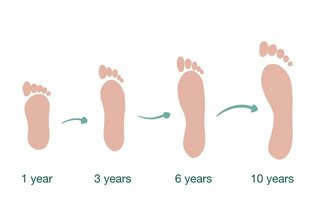Flat feet is where the arch of the inside of your foot is flatter than normal. Most children have flat feet up until about age 6 or 7.
Up until then you may only see your child’s arches:
- when they are sitting
- when their big toe is bent backwards
- if they stand up on their tiptoes
Some children will continue to have flat feet. About 1 in 5 children never develops an arch but only a small number will ever have a problem.

Types of flat feet
There are 2 main types of flat feet in children:
- flexible flat feet
- pathological flat feet
Flexible flat feet
Flexible flat feet means your child’s feet are flat but when they stand up on their tiptoes you can see their arch.
Pathological flat feet
Pathological flat feet means your child’s feet are flat due to a health condition.
This may be caused by:
- a neuromuscular disease such as cerebral palsy or spina bifida
- a rigid flat foot - their foot does not have an arch when they stand on their tiptoes
- a foot that changed shape
- a painful flexible flat foot
Sometimes only 1 foot is flat. The other has an arch.
Non-urgent advice: Contact your GP if:
- your child has a pathological flat foot
Treatment for flat feet
Your child does not need any treatment if they have a flexible flat foot and no other symptoms.
Non-urgent advice: Contact a physiotherapist or GP if
your child has a flexible flat foot and:
- pain
- problems running
- issues with balance
A physiotherapist can recommend exercises and advise you on the best shoes for your child to wear.
Find out about a physiotherapy assessment for your child at your local primary care centre.
Or you can arrange a private physiotherapy assessment.
Find a physiotherapist - iscp.ie
Causes of flat feet
The bones in the foot are held together by bands of tissue called ligaments. Flat feet are usually caused by loose ligaments and baby fat between the bones of the foot. These cause the arch to flatten when your child stands up. It is sometimes called fallen arches.
